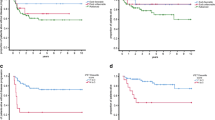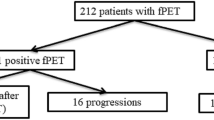Abstract
Background
Interim 18F-FDG PET helps predict outcome and tailor treatment in adults with Hodgkin disease (HD).
Objective
The purpose of this study was to assess predictive values of interim 18F-FDG PET/CT in children with HD and to define the potential added value to interim PET of low-dose CT.
Materials and methods
Children were prospectively enrolled August 2002–April 2007. PET/low-dose CT was performed at staging, after 2 cycles, at the end of treatment and during follow-up (mean 45 months). Treatment was unchanged regardless of interim results. PET and low-dose CT were read independently.
Results
Of 34 enrolled children (ages 3–17 years), 27 achieved complete response, 4 had progressive disease and 3 had relapse. Interim PET alone had positive and negative predictive values of 67% and 89%, respectively. Interim low-dose CT alone had positive and negative predictive values of 35% and 100%, respectively. Interim PET/CT had positive and negative predictive values of 75% and 96%, respectively.
Conclusions
Early interim PET/CT was a good predictor of outcome. Integrated PET and low-dose CT improved the predictive value in children with HD.

Similar content being viewed by others
References
Cheson BD, Pfistner B, Juweid ME et al (2007) Revised response criteria for malignant lymphoma. J Clin Oncol 25:579–586
Juweid ME, Stroobants S, Hoekstra OS et al (2007) Use of positron emission tomography for response assessment of lymphoma: consensus of the imaging subcommittee of international harmonization project in lymphoma. J Clin Oncol 25:571–578
Hoekstra OS, Ossenkoppele GJ, Golding R et al (1993) Early treatment response in malignant lymphoma, as determined by planar fluorine-18-fluorodeoxyglucose scintigraphy. J Nucl Med 34:1706–1710
Kostakoglu L, Coleman M, Leonard JP et al (2002) PET predicts prognosis after 1 cycle of chemotherapy in aggressive lymphoma and Hodgkin’s disease. J Nucl Med 43:1018–1027
Torizuka T, Nakamura F, Kanno T et al (2004) Early therapy monitoring with FDG-PET in aggressive non-Hodgkin’s lymphoma and Hodgkin’s lymphoma. Eur J Nucl Med Mol Imaging 31:22–28
Hutchings M, Mikhaeel NG, Fields PA et al (2005) Prognostic value of interim FDG-PET after two or three cycles of chemotherapy in Hodgkin lymphoma. Ann Oncol 16:1160–1168
Hutchings M, Loft A, Hansen M et al (2006) FDG-PET after two cycles of chemotherapy predicts treatment failure and progression-free survival in Hodgkin lymphoma. Blood 107:52–59
Zinzani PL, Tani M, Fanti S et al (2006) Early positron emission tomography (PET) restaging: a predictive final response in Hodgkin’s disease patients. Ann Oncol 17:1296–1300
Gallamini A, Rigacci L, Merli F et al (2006) The predictive value of positron emission tomography scanning performed after two courses of standard therapy on treatment outcome in advanced stage Hodgkin’s disease. Haematologica 91:475–481
Gallamini A, Hutchings M, Rigacci L et al (2007) Early interim 2-[18F]fluoro-2-deoxy-D-glucose positron emission tomography is prognostically superior to international prognostic score in advanced-stage Hodgkin’s lymphoma: a report from a joint Italian–Danish study. J Clin Oncol 25:3746–3752
Furth C, Steffen IG, Amthauer H et al (2009) Early and late therapy response assessment with [18F]fluorodeoxyglucose positron emission tomography in pediatric Hodgkin’s lymphoma: analysis of a prospective multicenter trial. J Clin Oncol 27:4385–4391
Bar-Sever Z, Keidar Z, Ben-Barak A et al (2007) The incremental value of 18F-FDG PET/CT in paediatric malignancies. Eur J Nucl Med Mol Imaging 34:630–637
Keller FG, Castellino SM, Nachman JB (2009) What is the best treatment for children with limited-stage Hodgkin lymphoma? Curr Hematol Malig Rep 4:129–135
Mauz-Körholz C, Hasenclever D, Dörffel W et al (2010) Procarbazine-free OEPA-COPDAC chemotherapy in boys and standard OPPA-COPP in girls have comparable effectiveness in pediatric Hodgkin’s lymphoma: the GPOH-HD-2002 study. J Clin Oncol 28:3680–3686
Borchmann P, Diehl V, Engert A (2011) ABVD versus BEACOPP for Hodgkin’s lymphoma. N Engl J Med 365:1545–1546
Schwartz CL, Constine LS, Villaluna D et al (2009) A risk-adapted, response-based approach using ABVE-PC for children and adolescents with intermediate- and high risk Hodgkin lymphoma: the results of P9425. Blood 114:2051–2059
Diehl V, Franklin J, Pfreundschuh M et al (2003) Standard and increased dose BEACOPP chemotherapy compared with COPP–ABVD for advanced Hodgkin’s disease. N Engl J Med 348:2386–2395
Cheson BD, Pfistner B, Juweid ME (1999). Report of an international workshop to standardize response criteria for non-Hodgkin’s lymphoma. NCI Sponsored International Workshop Group. J Clin Oncol 1244–1253
Meany HJ, Gidvani VK, Minniti CP (2007) Utility of PET scans to predict disease relapse in pediatric patients with Hodgkin lymphoma. Pediatr Blood Cancer 48:399–402
Levine JM, Weiner M, Kelly KM (2006) Routine use of PET scans after completion of therapy in pediatric Hodgkin disease results in a high false positive rate. J Pediatr Hematol Oncol 28:711–714
Miller E, Metser U, Avrahami G et al (2006) Role of 18F-FDG PET/CT in staging and follow-up of lymphoma in pediatric and young adult patients. J Comput Assist Tomogr 30:689–694
MacManus MP, Seymour JF, Hicks RJ (2007) Overview of early response assessment in lymphoma with FDG-PET. Cancer Imaging 7:10–18
Haioun C, Itti E, Rahmouni A et al (2005) FDG-PET in aggressive lymphoma: an early prognostic tool for predicting patient outcome. Blood 106:1376–1381
Hutchings M, Barrington SF (2009) PET/CT for therapy response assessment in Lymphoma. J Nucl Med 50:21s–30s
Author information
Authors and Affiliations
Corresponding author
Rights and permissions
About this article
Cite this article
Ilivitzki, A., Radan, L., Ben-Arush, M. et al. Early interim FDG PET/CT prediction of treatment response and prognosis in pediatric Hodgkin disease—added value of low-dose CT. Pediatr Radiol 43, 86–92 (2013). https://doi.org/10.1007/s00247-012-2517-9
Received:
Revised:
Accepted:
Published:
Issue Date:
DOI: https://doi.org/10.1007/s00247-012-2517-9




